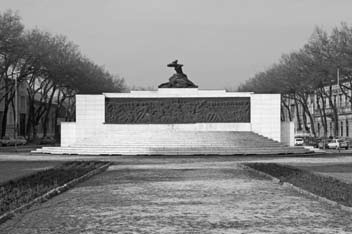The monument to the fallen soldiers and victims of fascist terror has been in function of the mausoleum since November 1946, when the remains of a giant of the Subotica workers’ movement and revolutions of gunmen, hanged or killed in the liberation struggle of this region were laid with the solemn commemoration.
The monument consists of three parts: the postament, the access plateau and the tomb. The postament, a sculptural body carrier, built with a natural concrete core and partially covered with bricks, with a stone lining of limestone (after restoration of the marble), carries a bronzed relief frieze, slightly curved, on the front side. The upper side of the wall carries a group figure also of bronze, centrally placed, while the northern side of the wall functions in a tomb with centrally placed bronze gate, which contains the remains of fifteen citizens of Subotica. Bronze slabs with names of fallen fighters and victims of fascism, and bronze inscriptions from 1941-1945 were placed around the entrance (by Peter Černe, Slovenian sculptor, 1969). The wall ends on the sides of the pylons.
The access plateau is made in two levels, the first lower with three steps, and the second level is the outer tomb of the tomb, which from eight steps leads to a semicircular plateau in front of the relief frieze.
The tomb itself is semi-tiled, the walls are brick-built with bricks in the extension mortar, and the ceiling construction is made of radially arranged carriers, a shallow arch of brick. After the liberation of Subotica, on October 10, 1944, that is, after the end of the war with the Day of Victory over Fascism, on May 9, 1945, the fourth period of commemorative construction began in the city. At the very beginning, several conventional memories were formed, similar to traditional-cemetery-memorials. The competition for the first post-war monument in the true sense of the word was announced in accordance with the then valid norms of the proceedings, on November 8, 1946, and was open to the participation of all Yugoslav citizens. The competition for the Subotica Monument was allegedly “successful” by Gajdos (one of the jury members). The first prize was received by the proposal of the Belgrade sculptor Dragutin Spasic,which is no longer among the most important authors in the Yugoslav sculpture. However, according to Tibor Gajdosa’s testimony, Spasic will also be “lost” in Subotica. Namely, in the early 1950s, the design of the monuments would be entrusted to the distinguished sculptor Tomi Rosandić (1878-1958).
Rosandić, a magnificent sculptor and long-time popular, is present on the visual art scene since 1906, the author of several monuments (his composition “Playing horses in the hole” in front of the National Assembly in Belgrade). He is known as an outstanding pedagogue, he became a master-sculptor in 1947 and was entrusted with master’s workshop. Associates, or pupils, were extremely talented young sculptors with an already finished art academy (Ante Gržetić, Olga Jančić, Jovan Soldatović, Sava Sandić, Ratko Stojadinović).
The Monument in Subotica was officially unveiled on October 30, 1952. From the war on here, it was the third in a row in Vojvodina, but the first by the new, modern concept of shaping public monuments, without the theatricality of socrealistic heroics and demagogic messages! The monument to the fallen soldiers and victims of fascism clearly expresses the determination of Tom Rosandić to form a memorial of enduring values and universal significance, without ideological attributes and template demagogues recognizable in products of socialist realism. The relief surface of the horizontally placed bronze indicates the conflict of good and evil, the triumphant finish of the struggle. In the center of the relief, the winner is a dignified axis of events, a peaceful human figure, as well as others without clothes and a sign of belonging to any of the conflicting sides. From the winners left and right,in a combat sword of athletic bodies as if the battle was falling. Alongside this predominantly rhythmic wave of “life-form” from the center to the two sides, the form is divided into horsemen who are crazy with the skill of victory (peace). In the very corner, the opponent is thrown and disabled. Behind this basketball, which is actually a masterfully composed game of form, the poster is a finishing one, a pyramidal composition full of plastic, girls of the breasts and lush forms, or the body of a young athlete. Both figures are an expression of life force. The laurel wreath, with which a girl wraps a lifeless body, is the only sign of death. The corpus memorial – the white volume developed in the horizon expresses the piety, the function is a chestnut tree, but the life forms of plastic expression exudes vitality! The universal message monument and durable plastic values,harmoniously incorporated and coexisted with the environment. A prominent horizontal of the monument consciously avoided dualism with a close vertical of the baroque tower of the cathedral. At an elongated level of the market, he has the support of the surrounding volumes and in the perspective view of the prey with the dignity of a calm mass, “calm” with the ambience.
In 1985, remediation and reconstruction of monuments was performed:
The project for rehabilitation and restoration was made by the Inter-municipal Institute for the Protection of Cultural Monuments, Subotica.
Designers: Ante Rudinski, dipl.ing.arh., Roža Pletikosić, dipl.ing.građ., Duško Gencel, dipl.ing.građ.
Contractor: Construction company “Integral” Subotica.
MONUMENT TO FALLEN SOLDIERS AND VICTIMS OF FASCISM


0 comments on “MONUMENT TO FALLEN SOLDIERS AND VICTIMS OF FASCISM”